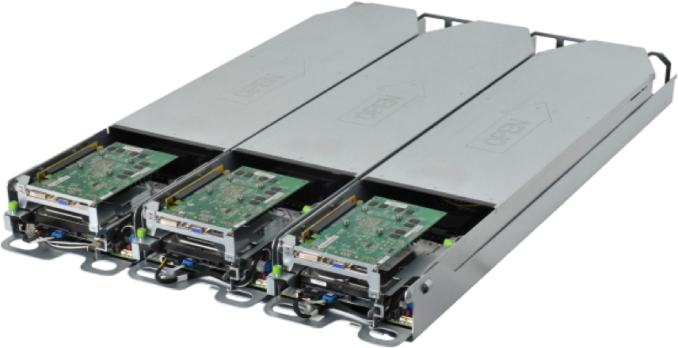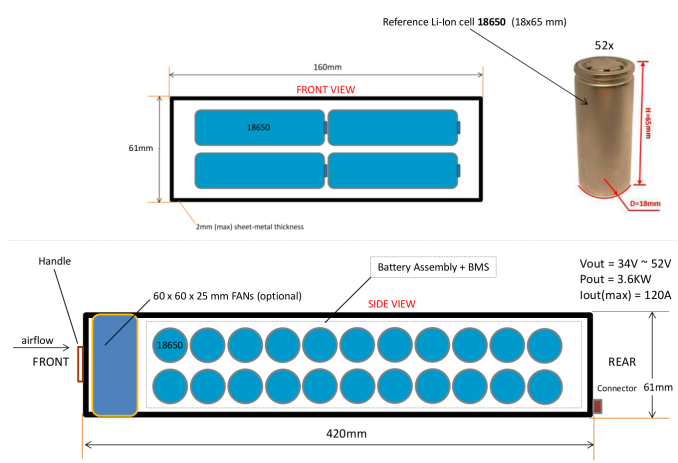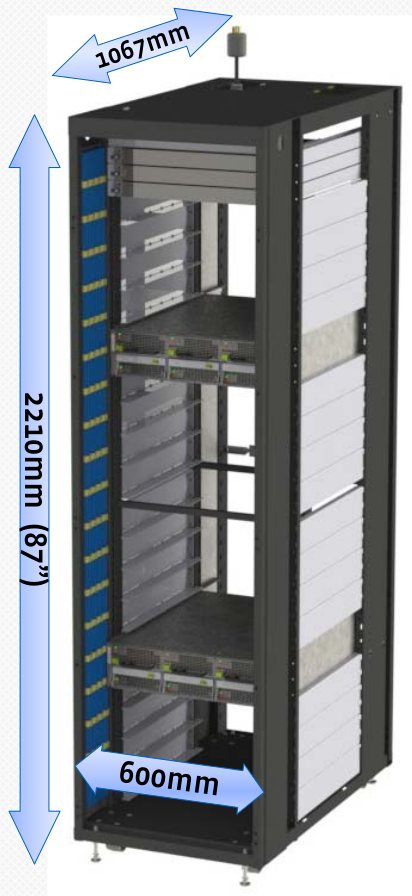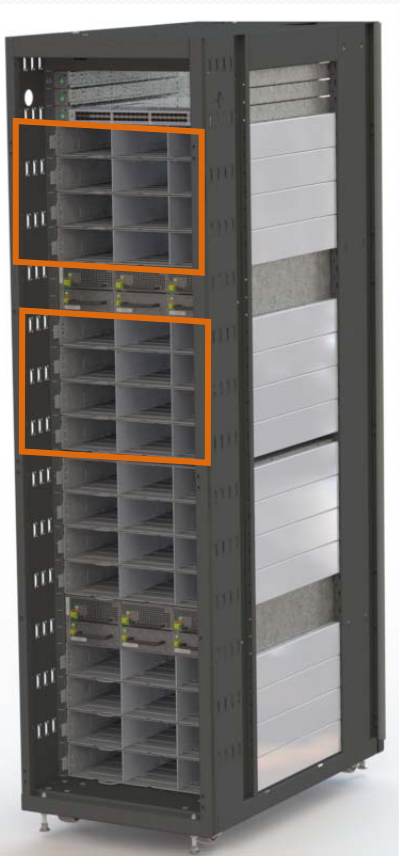The Next Generation Open Compute Hardware: Tried and Tested
by Johan De Gelas & Wannes De Smet on April 28, 2015 12:00 PM ESTThe Next Generation: Winterfell
With the PSU and hard disks removed from the server, the only items left in a Freedom chassis were the motherboard, fans and one boot drive. When Facebook's engineers put these things together in a smaller form factor, they created Winterfell, a compute node that's similar to a Supermicro twin node, except in ORv1 three nodes can be placed on a shelf. One Winterfell node is 2 OU high, and consists of a modified Windmill motherboard, a bus bar connector, and a midplane connecting the motherboard to the power cabling and fans. The motherboard is equipped with a slot for a PCIe riser card – on which a full size x16 PCIe card and a half size x8 card can be placed – and a x8 PCIe mezzanine connector for network interfaces. Further connectivity options include both a regular SATA and mSATA connector for a boot drive.

Winterfell nodes, fitted here with optional GPU
But Facebook's ever advancing quest for more efficiency found another target. After an ORv1 deployment in Altoona, it became apparent that having three power zones with three bus bars each was capable of delivering far more power than needed, so they took that information and went on to design the successor, the aptly named OpenRack v2. OpenRack v2 only uses two power zones instead of three, and FB's implementation has only one bus bar segment per power zone, bringing further cost reductions (though the PDU built into the rack is still able to power three). The placement of the power shelves relative to the bus bars was given another thought, this time they were put in the middle of a power zone because of the voltage drop in the bus bar when conducting power from the bottom to the top server. ORv2 also allows for some more ToR machinery by increasing the top bay height to 3 OU.
Open Rack v2, with powerzones on the left. ORv2 filled with Cubby chassis on the right. The chassis marked by the orange rectangle fit 12 nodes. (Image Courtesy Facebook)
The change in power distribution resulted in incompatibility with Winterfell, as the bus bars for the edge nodes are now missing, and so Project Cubby saw the light of day. Cubby is very similar to a Supermicro TwinServer chassis, but instead of having PSUs built in, it plugs into the bus bar and wires three internal power receptacles to power each node. The Winterfell design also needed to be shortened depth-wise, so the midplane was removed.
Another cut in upfront costs was realized by using three (2+1 redundancy) 3.3 kW power supplies instead of six per power zone. With the amount of power zones decreased, each of the two power zones can deliver up to 6.3 kW in ORv2. This freed up some space on the power shelf, so the engineers decided to end the separate battery cabinet that was placed next to the racks. The bottom half of the power shelf now contains three Battery Backup Units (BBU). Each BBU comes with a matrix of Li-ion 18650 cells, equal to those found in a Tesla's battery pack, capable of providing 3.6 kW to bridge the power gap until the generators kick in. Each BBU is paired to a PSU, when the PSU drops out the BBU is active until power is restored.

BBU Schematic (Image Courtesy Facebook)
To summarize, by broadening focus to your bog-standard EIA 19" rack and developing a better integration with the servers and battery cabinets, Facebook was able to reduce costs and added capacity for an additional rack per row.












26 Comments
View All Comments
Kevin G - Tuesday, April 28, 2015 - link
Excellent article.The efficiency gains are apparent even using suboptimal PSU for benchmarking. (Though there are repeated concurrency values in the benchmarking tables. Is this intentional?)
I'm looking forward to seeing a more compute node hardware based around Xeon-D, ARM and potentially even POWER8 if we're lucky. Options are never a bad thing.
Kind of odd to see the Knox mass storage units, I would have thought that OCP storage would have gone the BackBlaze route with vertically mount disks for easier hot swap, density and cooling. All they'd need to develop would have been a proprietary backplane to handle the Kinetic disks from Seagate. Basic switching logic could also be put on the backplane so the only external networking would be high speed uplinks (40 Gbit QSFP+?).
Speaking of the Kinetic disks, how is redundancy handled with a network facing drive? Does it get replicated by the host generating the data to multiple network disks for a virtual RAID1 redundancy? Is there an aggregator that handles data replication, scrubbing, drive restoration and distribution, sort of like a poor man's SAN controller? Also do the Kinetic drives have two Ethernet interfaces to emulate multi-pathing in the event of a switch failure (quick Googling didn't give me an answer either way)?
The cold storage racks using Blu-ray discs in cartridges doesn't surprise me for archiving. The issue I'm puzzled with is the process how data gets moved to them. I've been under the impression that there was never enough write throughput to make migration meaningful. For a hypothetical example, by the time 20 TB of data has been written to the discs, over 20 TB has been generated that'd be added to the write queue. Essentially big data was too big to archive to disc or tape. Parallelism here would solve the throughput problem but that get expensive and takes more space in the data center that could be used for hot storage and compute.
Do the Knox storage and Wedge networking hardware use the same PDU connectivity as the compute units?
Are the 600 mm wide racks compatible use US Telecom rack width equipment (23" wide)? A few large OEMs offer equipment in that form factor and it'd be nice for a smaller company to mix and match hardware with OCP to suit their needs.
nils_ - Wednesday, April 29, 2015 - link
You can use something like Ceph or HDFS for data redundancy which is kind of like RAID over network.davegraham - Tuesday, April 28, 2015 - link
Also, Juniper Networks has an ONIE-compliant OCP switch called the OCX1100 which is the only Tier1 switch manufacturer (e.g. Cisco, Arista, Brocade) to provide such a device.floobit - Tuesday, April 28, 2015 - link
This is very nice work. One of the best articles I've seen here all year. I think this points at the future state of server computing, but I really wonder if the more traditional datacenter model (VMware on beefy blades with a proprietary FC-connected SAN) can be integrated with this massively-distributed webapp model. Load-balancing and failovering is presumably done in the app layer, removing the need for hypervisors. As pretty as Oracle's recent marketing materials are, I'm pretty sure they don't have an HR app that can be load-balanced on the app layer in alongside an expense app and an ERP app. Maybe in another 10 years. Then again, I have started to see business suites where they host the whole thing for you, and this could be a model for their underlying infrastructure.ggathagan - Tuesday, April 28, 2015 - link
In the original article on these servers, it was stated that the PSU's were run on 277v, as opposed to 208v.277v involves three phase power wiring, which is common in commercial buildings, but usually restricted to HVAC-related equipment and lighting.
That article stated that Facebook saved "about 3-4% of energy use, a result of lower power losses in the transmission lines."
If the OpenRack carries that design over, companies will have to add the cost of bringing power 277v to the rack in order to realize that gain in efficiency.
sor - Wednesday, April 29, 2015 - link
208 is 3 phase as well, generally 3x120v phases, with 208 tapping between phases or 120 available to neutral. Its very common for DC equipment. 277 to the rack IS less common, but you seemed to get hung up on the 3 phase part.Casper42 - Monday, May 4, 2015 - link
3 phase restricted to HVAC?Thats ridiculous, I see 3 Phase in DataCenters all the time.
And Server vendors are now selling 277vAC PSUs for exactly this reason that FB mentions. Instead of converting the 480v main to 220 or 208, you just take a 277 feed right off the 3 phase and use it.
clehene - Tuesday, April 28, 2015 - link
You mention a reported $2 Billion in savings, but the article you refer to states $1.2 Billion.FlushedBubblyJock - Tuesday, April 28, 2015 - link
One is the truth and the other is "NON Generally Accepted Accounting Procedures" aka it's lying equivalent.wannes - Wednesday, April 29, 2015 - link
Link corrected. Thanks!